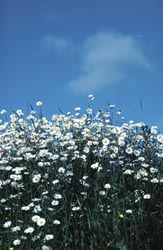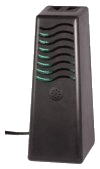The Top 10 Allergy Capitals of the United States:
Where NOT to Live if You Have Allergies
by www.SixWise.com
In the United States, 60 million people -- or one out of four Americans -- suffer from allergies and asthma, according to the Asthma and Allergy Foundation of America (AAFA). Allergies are actually the 5th leading chronic disease in the United States, and the 3rd most common chronic disease among children under 18.
|

The severity of allergy season varies depending on where you live. Do you live in one of the worst allergy capitals?
|
Among them, 40 million Americans have indoor/outdoor allergies as their primary allergy, which can make springtime, and also fall, miserable.
Aside from the lousy, cold-like symptoms that allergies provoke (sneezing, congestion, watery/itchy eyes, runny nose, etc.), allergies can cost you days at work and money to seek out solutions. In fact, according to the American Academy of Allergy, Asthma & Immunology (AAAAI), allergies may cost Americans close to $8 billion a year in costs related to direct care and lost work productivity.
And this year experts say many parts of the country are experiencing worse than usual allergy seasons. As reported by CNN, in the Pacific Northwest a cold winter rapidly gave way to warm spring temperatures that caused many plants to release their pollen at the same time. In the South, meanwhile, pollen levels peaked in February, dropped, then rose again in March, making allergic reactions even worse than before.
Of course, while allergies can occur in any part of the country, certain areas of the United States will always be more problematic than others.
2009 Allergy Capitals
AAFA has identified the 100 most challenging places to live with allergies in both the spring and fall seasons. The rankings are based on scientific analysis of three factors for 100 metro areas, including:
-
Pollen scores (airborne grass/tree/weed pollen and mold spores)
-
Number of allergy medications used per patient (over-the-counter and prescription)
-
Number of allergy specialists per patient
|
Purify Your Air of Allergens,
Fast, With PIONAIR
With the PIONAIR Air Treatment System you can remove pollen, smoke, dust, pet dander, mold, bacteria, and other allergens from your home and office air so you can breathe freely.
 All PIONAIR Systems include a 30-Day Money-Back Guarantee! All PIONAIR Systems include a 30-Day Money-Back Guarantee!
And for a LIMITED TIME ONLY, Get $30 Off Each PIONAIR Air Treatment Unit, Plus FREE SHIPPING and a FREE MiniMate Refrigerator Unit!
Choose Your Pionair System
and Order Now!
|
For 2009, the top spring capitals were:
-
Louisville, Kentucky
-
Knoxville, Tennessee
-
Charlotte, North Carolina
-
Madison, Wisconsin
-
Wichita, Kansas
-
McAllen, Texas
-
Greensboro, North Carolina
-
Dayton, Ohio
-
Little Rock, Arkansas
-
Augusta, Georgia
To view a list of the complete rankings, with 100 spring allergy capitals listed, visit AAFA.
“Anyone who lives in an Allergy Capital should take the necessary steps to minimize the impact of allergies on their life,” says Mike Tringale, director of external affairs for AAFA in an AAFA news release. “The Allergy Capital ranking is a great tool to help increase awareness about what allergy sufferers can do to avoid allergy triggers and actually enjoy the spring season.”
The good news is that there are a number of ways to ease your outdoor allergies that don't cost much money and that don't take much effort to do. If you are one of the many people battling with seasonal allergies this spring, try out as many of the tips below as you can ... and you should experience a great deal of relief, no matter where you live.
10 Tips to Minimize Your Seasonal Allergies
-
Keep your windows closed to keep pollen out (this is especially important from 5 a.m. to 10 a.m. when plants release most of their pollen). This includes while you’re driving.
-
Use your air conditioner instead of opening windows, and ideally use an air conditioner that has an allergy-reducing HEPA filter in it.
|
The Largely Unknown Key to Keeping Allergens Out of Your Indoor Air? Waterhog Grand Premier Mats and Rugs

Every step you take into your home presents an opportunity for allergens to get in, and those allergens are circulated in the air you breathe. That's why The Waterhog Grand Premier Mats and Rugs, placed strategically around your home at entranceways and highly trafficked areas, are essential to keeping your home air clean!
These premier decorative mats and rugs:
- Keep Dirt and Liquids Beneath Shoe Level
- Dry Very Fast and Resist Corrosion
- Won't Slip
- Last Much Longer Than Other Mats
- Are Simple to Clean
- Are Attractive and Affordable
- Can be used Indoors or Outdoors
- Come in a Variety of Colors & Sizes
Learn Why You Should Avoid Other Mats, Why The Waterhog Grand Premier Mats are Superior!
|
- Check the daily pollen and mold counts (AAAAI's National Allergy Bureau has daily pollen counts for locations across the country, as does Pollen.com. If counts are high, stay indoors as much as possible. Also stay indoors if it's windy, as dust and pollen will be blown about.
When pollen and mold counts are high, spend more time indoors.
-
Wash your bedding once a week in hot water to help get rid of dust mites and other allergy triggers. Even better, throw in a 100% Hypoallergenic Static Eliminator Reusable Dryer Sheet with your dryer load to take static cling out and soften fabric -- without any toxic and potentially allergenic chemicals
-
Clean your home frequently to reduce pollen, mold, dust and other allergens. The PerfectClean line of mops, dusters, towels and more, which is used by leading hospitals and other health care organizations, is ideal for this. Rather than just pushing dust around, or worse, stirring it up into the air, PerfectClean's EasyGrip Mop and Flexible Duster are made with positively charged ultramicrofibers that pick up everything in their path -- including dust and all of its microscopic attachments.
-
If you spend time outside, change your clothes and wash your hair when you come inside to remove pollen and other allergens. Also resist the temptation to hang your clothes out in the sun to dry. When you bring them inside, they'll be covered in pollen and mold.
-
Filter your home's air -- many allergic reactions are triggered by airborne particles. Sixwise highly recommends the PIONAIR Air Treatment System, as unlike most air purifiers, the PIONAIR™ Air Treatment System doesn't wait for pollutants to contact a filter or plate. Instead, the PIONAIR generates air-purifying technology that migrates through the area and neutralizes organic odors, microbes, & molds at their source. As a result, the PIONAIR produces fresh clean air throughout your home uniformly, by addressing the pollutant source -- without the use of fans, filters, or plates!
|

You can always check pollen counts in your area by visiting Pollen.com.
|
-
Have someone else mow your lawn. Cutting the grass will expose you to a host of pollens and molds (the same goes for raking leaves in the fall).
-
Wipe off surfaces you touch often. Surfaces such as computer keyboards, countertops, furniture, door handles and appliances can be loaded with allergens. When you touch these areas, the allergens are transferred to your hands and then likely to your eyes, nose and mouth, potentially worsening your symptoms. Giving these areas a quick wipe with PerfectClean high-quality, commercial-grade microfiber cloths will keep all types of allergens to a minimum.
-
An astounding 85 percent of household "dirt" is carried into your house from the outside, so strategically placing high-quality mats in highly trafficked areas like entrances can dramatically reduce the amount of dirt, dust and allergens that are tracked into your home (and spread via your indoor air).
It is key to use the right type of mats -- AVOID cotton, coir and other fibers, and wood and metal mats, as they can increase versus help the problem. The Waterhog Grand Premier mats are our top-recommended choice for a "healthy" mat (that also looks great!).
Recommended Reading
Are Certain Foods Making Your Spring Allergies Worse?
The Four Most Dangerous Allergies and How to Prevent Them
Sources
Asthma and Allergy Foundation of America 2009 Spring Allergy Capitals
CNN.com May 21, 2009
Asthma and Allergy Foundation of America 2008 Spring Allergy Capitals